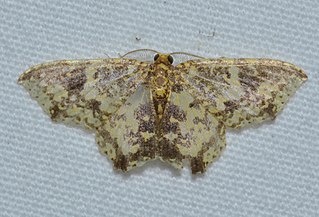
Eois is a genus of moths in the family Geometridae. The genus contains about 250 validly described species, most from the Neotropical region. Many species are still undescribed and the total number of species is estimated to be over a 1,000 in the Neotropical region alone. The genus was first described by Jacob Hübner in 1818.

Sterrhinae is a large subfamily of geometer moths with some 3,000 described species, with more than half belonging to the taxonomically difficult, very diverse genera, Idaea and Scopula. This subfamily was described by Edward Meyrick in 1892. They are the most diverse in the tropics with the number of species decreasing with increasing latitude and elevation.
Tricentra necula is a moth in the family Geometridae first described by Herbert Druce in 1892. It is found in Panama.
Eois batea is a moth in the family Geometridae first described by Herbert Druce in 1892. It is found in Guatemala.
Eois binaria is a moth in the family Geometridae. It is found in Brazil and Colombia.
Eois carmenta is a moth in the family Geometridae first described by Herbert Druce in 1892. It is found in Guatemala.
Eois carnana is a moth in the family Geometridae first described by Herbert Druce in 1892. It is found in Guatemala and Brazil.
Eois cassandra is a moth in the family Geometridae first described by Herbert Druce in 1892. It is found in Panama.
Eois catana is a moth in the family Geometridae first described by Herbert Druce in 1892. It is found in Guatemala and Honduras.
Eois cedon is a moth in the family Geometridae first described by Herbert Druce in 1892. It is found in Guatemala.
Eois fulva is a moth in the family Geometridae. It was described from San Antonio.
Eois neclas is a moth in the family Geometridae first described by Herbert Druce in 1892. It is found in Guatemala.
Eois numeria is a moth in the family Geometridae first described by Herbert Druce in 1892. It is found in Guatemala.

Eois numida is a moth in the family Geometridae first described by Herbert Druce in 1892. It is found in South America, Mexico and Costa Rica.
Eois nundina is a moth in the family Geometridae first described by Herbert Druce in 1892. It is found in Mexico.
Eois obada is a moth in the family Geometridae first described by Herbert Druce in 1892. It is found in Mexico and Panama.
Eois occia is a moth in the family Geometridae first described by Herbert Druce in 1892. It is found in Costa Rica.
Eois odatis is a moth in the family Geometridae first described by Herbert Druce in 1892. It is found in Guatemala.
Eois ops is a moth in the family Geometridae first described by Herbert Druce in 1892. It is found in Mexico.
Eois tegularia is a moth in the family Geometridae. It is found in Brazil and in Cuba. It has also been recorded from North America.


